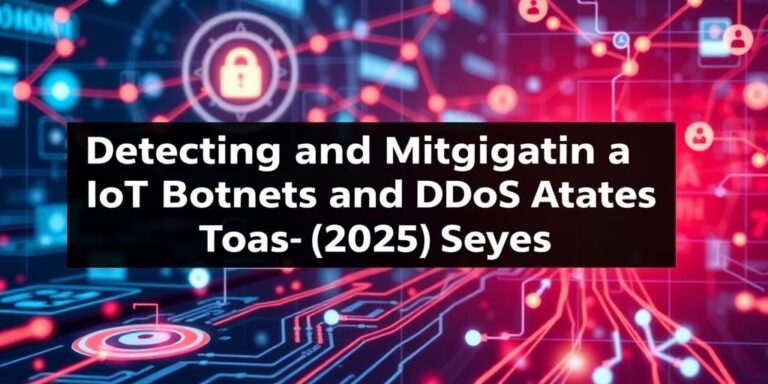Detecting and Mitigating IoT Botnets and DDoS Attacks (2026 Tools)
The Internet of Things (IoT) has revolutionized numerous aspects of our lives, connecting everyday devices to the internet. However, this increased connectivity has also created new security challenges. IoT botnets and Distributed Denial of Service (DDoS) attacks have become significant threats, capable of causing widespread disruption. This article explores the methods for detecting and mitigating these attacks, focusing on the tools and techniques expected to be available by 2026.
Understanding the Threat Landscape
IoT devices, often lacking robust security measures, are vulnerable to malware infections. Once infected, these devices can be recruited into botnets, which are then used to launch DDoS attacks. These attacks overwhelm target systems with malicious traffic, rendering them inaccessible to legitimate users. By 2026, the sophistication and scale of these attacks are expected to increase, necessitating advanced detection and mitigation strategies.
Evolution of IoT Botnets
- Increased Scale: Botnets will likely consist of millions of compromised IoT devices.
- Advanced Evasion Techniques: Malware will employ more sophisticated methods to avoid detection.
- Polymorphism: Botnet code will change frequently to evade signature-based detection.
DDoS Attack Trends
- Higher Bandwidth Attacks: Exploiting faster internet speeds to generate larger volumes of traffic.
- Multi-Vector Attacks: Combining multiple attack vectors to overwhelm defenses.
- Application-Layer Attacks: Targeting specific vulnerabilities in applications to disrupt services.
Detection Methods
Detecting IoT botnets and DDoS attacks requires a multi-faceted approach, combining network monitoring, anomaly detection, and behavioral analysis. By 2026, the following tools and techniques are expected to be crucial:
Network Monitoring
- Deep Packet Inspection (DPI): DPI tools analyze the content of network packets, identifying malicious patterns and signatures. Advanced DPI techniques will use machine learning to detect subtle anomalies.
- Flow Analysis: Analyzing network traffic flows to identify unusual patterns, such as sudden spikes in traffic volume or connections to suspicious IP addresses.
- Real-Time Traffic Analysis: Continuous monitoring of network traffic to detect anomalies as they occur, enabling rapid response.
Anomaly Detection
- Machine Learning (ML): ML algorithms can learn normal network behavior and detect deviations that indicate an attack. By 2026, ML-based detection systems will be more accurate and adaptive.
- Behavioral Analysis: Analyzing the behavior of IoT devices to identify those acting suspiciously. For example, a smart thermostat suddenly sending large amounts of data could be a sign of infection.
- Threshold-Based Detection: Setting thresholds for network traffic and device behavior, triggering alerts when these thresholds are exceeded.
Threat Intelligence
- Real-Time Threat Feeds: Subscribing to threat intelligence feeds that provide information about known botnet command-and-control servers and malware signatures.
- Honeypots: Deploying honeypots to attract and trap malware, providing insights into attack techniques and new threats.
- Sandboxing: Executing suspicious code in a sandboxed environment to analyze its behavior without risking the production network.
Mitigation Strategies
Once an attack is detected, timely and effective mitigation strategies are essential to minimize the impact. By 2026, the following methods are expected to be widely used:
Network-Based Mitigation
- DDoS Mitigation Services: Cloud-based DDoS mitigation services that filter malicious traffic before it reaches the target network. These services use advanced techniques such as traffic scrubbing and content delivery networks (CDNs).
- Firewall Rules: Implementing firewall rules to block traffic from known malicious IP addresses and ports.
- Traffic Shaping: Prioritizing legitimate traffic while rate-limiting or blocking suspicious traffic.
Device-Based Mitigation
- Firmware Updates: Regularly updating the firmware of IoT devices to patch security vulnerabilities. Automated update mechanisms will be critical.
- Device Segmentation: Isolating IoT devices on separate network segments to prevent the spread of malware.
- Secure Boot: Implementing secure boot mechanisms to ensure that only trusted software is executed on IoT devices.
Collaborative Mitigation
- Information Sharing: Sharing threat intelligence and attack information with other organizations to improve collective defense.
- Automated Response: Implementing automated response systems that can quickly react to detected threats, such as blocking malicious traffic or isolating infected devices.
- Industry Standards: Adopting industry standards and best practices for IoT security to ensure a consistent level of protection.
Emerging Technologies
Several emerging technologies are expected to play a significant role in detecting and mitigating IoT botnets and DDoS attacks by 2026:
- Artificial Intelligence (AI): AI-powered security systems that can automatically detect and respond to threats in real-time.
- Blockchain: Using blockchain technology to secure IoT devices and prevent tampering.
- 5G Security: Implementing security measures to protect 5G networks from IoT-based attacks.
Conclusion
The threat of IoT botnets and DDoS attacks is expected to grow in sophistication and scale by 2026. Effective detection and mitigation will require a combination of advanced tools, proactive strategies, and collaborative efforts. By implementing the methods outlined in this article, organizations can better protect their networks and devices from these evolving threats. Staying informed and continuously adapting security measures is crucial in the ongoing battle against IoT-based cyberattacks.




